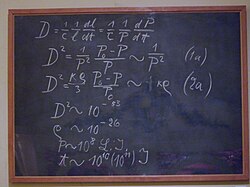Marconi's Coherer Receiver at Oxford Museum History of Science
Autor/Urheber:
Attribution:
Das Bild ist mit 'Attribution Required' markiert, aber es wurden keine Informationen über die Attribution bereitgestellt. Vermutlich wurde bei Verwendung des MediaWiki-Templates für die CC-BY Lizenzen der Parameter für die Attribution weggelassen. Autoren und Urheber finden für die korrekte Verwendung der Templates hier ein Beispiel.
Shortlink:
Quelle:
Größe:
2592 x 1944 Pixel (714700 Bytes)
Beschreibung:
A pioneering radio receiver using a coherer, a tube of metal filings, as a detector constructed by Italian radio inventor Guglielmo Marconi in 1896, on display in the Oxford Museum of the History of Science, UK. The coherer is the glass tube on the right. When it detected a radio signal it rang a bell. This receiver was used in a landmark 1896 demonstration of radio communication at Toynbee hall that made Marconi a celebrity. The transmitter that was used with it (metal balls) is seen on the left.
Caption on card: "Coherer receiver by Guglielmo Marconi, 1896: Marconi used this device for a famous public demonstration of wireless in London's Toynbee Hall in 1896. At a public lecture by William Preece, chief engineer of the General Post Office, whenever Preece switched a transmitter and created an electric spark, a bell rang in a box Marconi took to any part of the lecture room. There was no visible connection between the two. The demonstration caused a sensation and made Marconi a celebrity."
Caption on card: "Coherer receiver by Guglielmo Marconi, 1896: Marconi used this device for a famous public demonstration of wireless in London's Toynbee Hall in 1896. At a public lecture by William Preece, chief engineer of the General Post Office, whenever Preece switched a transmitter and created an electric spark, a bell rang in a box Marconi took to any part of the lecture room. There was no visible connection between the two. The demonstration caused a sensation and made Marconi a celebrity."
Lizenz:
Relevante Bilder
Relevante Artikel
History of Science MuseumDas History of Science Museum der Universität Oxford ist ein wissenschaftshistorisches Museum in der englischen Stadt Oxford. 2019 wurde das History of Science Museum von rund 148.000 Personen besucht. 2022 betrug die Besucherzahl etwa 127.000 Menschen. .. weiterlesen








